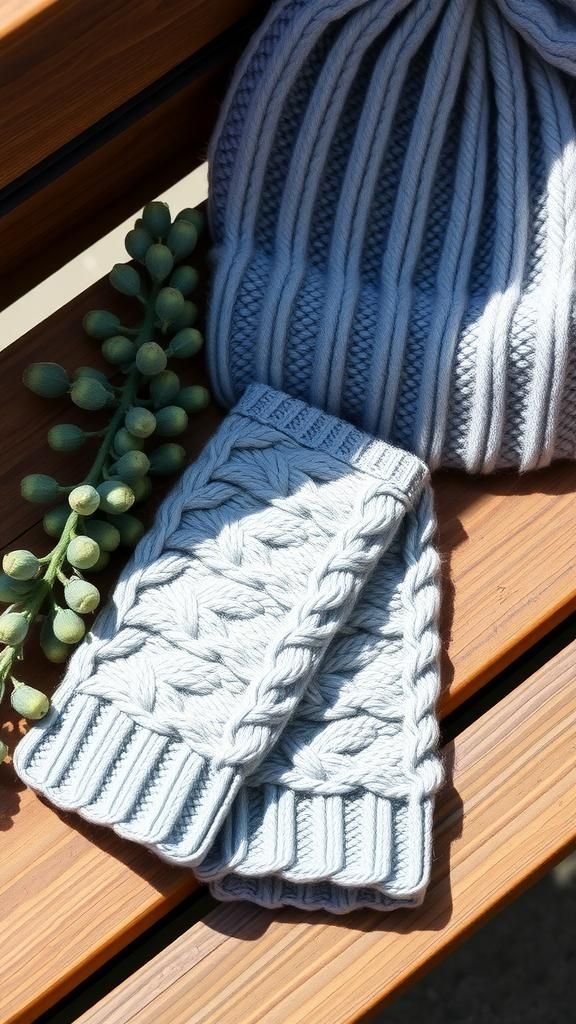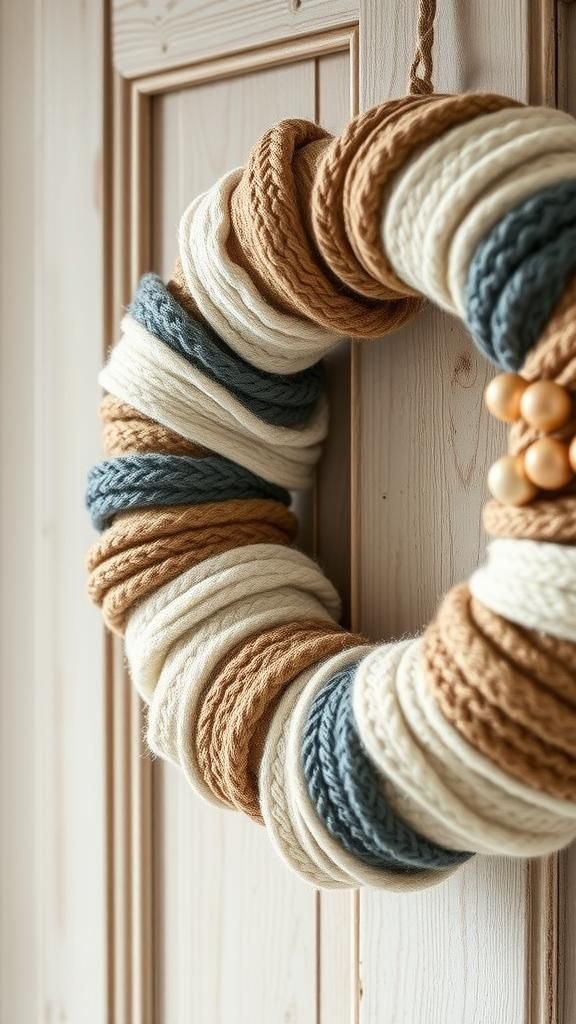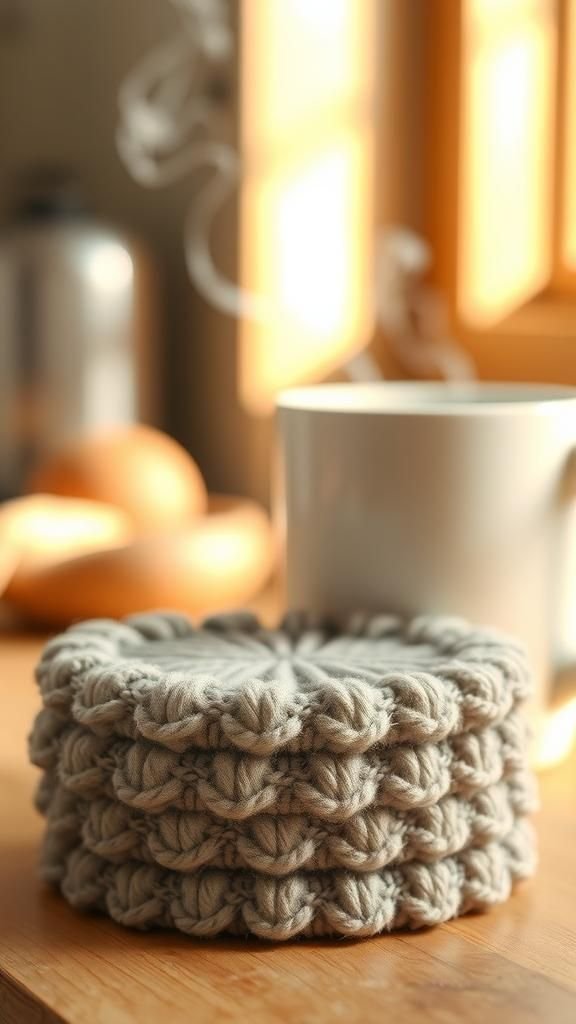Disclosure: This post contains affiliate links, which means we may earn a commission if you purchase through our links at no extra cost to you.
I started saving old sweaters after one cold evening when a favorite wool sleeve replaced a missing mug cozy. There’s something quietly joyful about transforming a worn cuff into a small thing that brightens daily winter rituals.
Upcycled sweater winter crafts have become my late-night, low-stress habit.
Working with thrifted knits feels tactile and forgiving. The textures, the smell of washed wool, and the occasional surprise pattern make each project feel like finding a hidden piece of someone’s life and giving it a second, cozier chapter.
These ideas are small, warm, and strangely comforting.
Table of Contents
Mug sweater cozy that hugs a warm cup

I love grabbing a mug wrapped in reclaimed knit; the ribbing cups the hand and the wool muffles the heat without hiding the steam. The old cuff often has tiny pills and faded stitches that add character, and when held up it looks like a miniature sweater.
The scent of laundry soap sometimes lingers, mixing with the faint toast of hot chocolate. It feels like a secret borrowed from a larger garment, a familiar texture that makes a simple drink feel like a ritual.
Steps
- Measure the height of the mug and mark that distance along the sleeve.
- Snip the marked section away from the rest of the garment with sharp fabric scissors.
- Trim uneven edges inside with small snips for a neat finish.
- Stitch the raw edges together along the seam line with evenly spaced running stitches.
- Turn the cozy right side out and slip it over the mug to check fit.
Fingerless mitts that keep thumbs free

There’s a satisfying contrast between the dense wool of an old sweater and the quick warmth of hand openings that let fingers move. These wrist-length mitts have a lived-in feel where the cuff once hugged the wrist, and the yarn fuzz catches the light in a pleasant halo.
Sliding them on while holding a camera or knitting needle feels practical and oddly luxurious. The texture warms the skin without making the palms slick, and the small opening for the thumb adds a functional silhouette that I reach for on chilly mornings.
Steps
- Place a hand on the sweater to estimate width, then mark two parallel lines for wrist and knuckle openings.
- Snip along the knuckle line to create the palm opening and reserve extra length for the thumb tunnel.
- Fold the edges inward and secure with basting stitches around the wrist perimeter.
- Stitch a short tunnel beside the thumb gap for added warmth and reinforcement.
- Finish with small overcast stitches along raw edges for a tidy look.
Ear warmer headband from an old neckline

When the neckline of a sweater is roomy, it becomes the most inviting band against the ears. I often find myself appreciating the way a reclaimed collar floats gently on the skin, trapping warmth without feeling bulky.
The stretch of the ribbing gives a snug fit and the faded colors sometimes create an attractive vintage stripe across the forehead. On windy days it muffles the chill and feels like a secret headband borrowed from someone’s rainy commute.
The tactile contrast between the knit and bare skin feels pleasantly homey.
Steps
- Stretch the sweater neckline around the widest part of the head to gauge comfort and mark excess.
- Snip away surplus fabric beyond the marked area while preserving the main band.
- Fold raw edges inward slightly and secure with a row of running stitches along the seam.
- Overlap ends slightly and stitch them together to create a continuous band.
- Tuck seams inside and secure with small hand stitches for a smooth finish.
Cable-knit beanie from a hat-shaped sleeve

That moment when an old sleeve becomes a little hat always makes me smile. The dense, twisting cables create a crown that feels familiar, like an heirloom reinterpreted.
Wearing it on brisk walks, the knit hums against the hair while the edge presses lightly against the forehead. The interior keeps a soft fuzz against the scalp and the outer pattern catches glints of winter sun.
It’s the kind of hat that invites compliments and pulls together a thrown-on outfit without much thought.
Steps
- Measure the head circumference and mark the sleeve accordingly for desired height.
- Snip the sleeve off at the marked height while keeping one end intact for shaping.
- Gather the top edge evenly and secure with tight running stitches to form a rounded crown.
- Reinforce the gathered center with a second row of stitches for durability.
- Trim excess threads and smooth the seam area for a finished look.
Patchwork lap throw that feels like a hug

A lap throw made from a mosaic of sweater squares has an intimacy that store-bought blankets lack. I remember spreading one over my knees while reading, its mixed textures pressing against the skin in a comforting chorus.
Patches of mohair, ribbing, and dense wool sit next to each other, creating a visual rhythm. The seams are slightly uneven in a way that feels handmade, and the overall weight has a reassuring gravity that warms from the center outward.
It’s an object that invites lingering afternoons and slow conversation.
Steps
- Cut sweater sections into similarly sized squares with even edges.
- Lay squares in a pleasing arrangement and pair complementary textures together.
- Sew adjoining edges with a durable straight stitch to join rows into a larger fabric.
- Reinforce outer seams with overcast stitching around the perimeter for stability.
- Finish by trimming stray threads and smoothing corners for a neat blanket edge.
Plush pillow cover that invites a nap

Transforming a cardigan front into a pillow cover feels like creating a tiny wearable for the sofa. The buttons, subtle color fades, and worn elbow spots become focal points that tell a story.
When I rest my head against one, the thick knit cushions with a gentle give and the worn areas add a lived-in comfort that smooth fabrics can’t match. The smell of home laundry sometimes lingers, making the moment feel domestic and warm.
It’s the kind of pillow that makes afternoon dozing a deliberate pleasure.
Steps
- Measure the pillow insert and mark corresponding dimensions on the sweater panel.
- Snip the panel to size, preserving any decorative features like buttons.
- Create a back panel of the same dimensions and align right sides together.
- Stitch around three edges with a secure seam, leaving one side open for the insert.
- Insert the pillow and close the final edge with a neat ladder stitch.
Pet bed with a sweater shell and soft filling

Seeing a small pet burrow into a sweater bed is a little moment of triumph. The sweater walls slump just enough to form a nest while the fuzz traps tiny tufts of fur and warmth.
The texture muffles movement and the scent feels like a gentle reminder of the human who made it. When the animal curls inside, the knit molds around their shape, offering a gentle gravity.
It’s not pristine, but it’s exactly what an animal seems to prefer: soft, slightly imperfect, and faintly perfumed by home.
Steps
- Select a large sweater and mark the base size to match the pet’s curled position.
- Snip the sweater along the marked base and reserve the torso section for walls.
- Stuff the base with soft batting or an old pillow to desired squishiness.
- Sew the sweater walls to the base with sturdy stitches, creating a shallow bowl shape.
- Reinforce the seam between base and walls with an extra row of stitching.
Mini sweater ornaments for winter greenery

Tiny sweater ornaments bring a handmade touch to a branch or garland, each one carrying a memory of a past season. I often find myself smiling at the miniature sleeves that echo full-sized garments; their puckered ribbing and faint stains look like history condensed.
Hanging close to fairy lights, the tiny stitches catch the glow and project a warm shadow. They feel fragile and personal, the sort of thing that prompts a story when guests notice.
The textures vary dramatically and that variety feels charming rather than mismatched.
Steps
- Trace a small sweater shape on the fabric and snip out matching front and back pieces.
- Sandwich a thin layer of batting between the two pieces for slight bulk.
- Sew around the edges with a neat whipstitch, leaving a small opening for filling.
- Fill gently and finish the seam to close the ornament completely.
- Add a hanging loop by stitching a short ribbon or cord into the top seam.
Long stocking that feels homespun and soft

A hand-stitched stocking seems to gather small moments as it hangs by the hearth. The cuff from the original sweater often becomes a textured trim, and a mismatched button or two adds a whimsical smile.
I remember the scent of cedar and the soft scratch of wool against the mantle when I reach for it. The body of the stocking sags just enough to hint at past contents, and the patchwork colors look like a quiet memory of winters past.
It hangs like a small, hopeful pocket waiting for hands to explore.
Steps
- Trace a stocking outline onto sweater fabric, keeping one straight edge for the cuff.
- Snip two identical stocking shapes and align them with right sides facing.
- Sew around the perimeter, leaving the top open for turning and filling.
- Turn the stocking right side out and smooth seams before finishing the cuff edge.
- Attach a sturdy loop at the heel seam for hanging by the mantle.
Hot water bottle cover that breathes warmth slowly

A sweater cover softens the harsh plastic outline of a hot water bottle and lends a tactile comfort that feels more human. The knit soaks up the heat and releases it in a gentle rhythm, while the woolly surface invites lingering against a chilled back.
I remember tucking one behind my shoulders during a long evening and feeling the slow translation of warmth into calm. The old pilling and slight stretching only add to the sense of something well-loved, and the soft texture becomes part of the ritual of settling in.
Steps
- Measure the hot water bottle and mark a rectangle on a sweater section for a snug sleeve.
- Snip the marked rectangle and shape one end into a rounded bottom.
- Sew along the rounded edge and up one side to form a pocket.
- Hem the open top by folding its raw edge inward and securing with a row of stitches.
- Slip the bottle into the cover and check that the fit feels secure and cozy.
Wreath from sweater strips and soft stuffing

A sweater wreath has an almost rustic, lived-in charm that feels seasonal without being flashy. Strips of knit curl around a form, their edges soft and slightly fuzzy, creating a depth that artificial materials rarely match.
I like the way different stitches nest together; a chunky rib beside a smooth stockinette creates an organic rhythm. The wreath sits on the door and the fabric muffles wind sounds, while the palette of faded dyes reads like a gentle invitation.
It has a quiet presence that suits cold-weather porches.
Steps
- Cut sweater pieces into long strips of even width suitable for wrapping.
- Wrap strips around a foam or rope base, overlapping to build even coverage.
- Tuck ends under adjacent wraps and secure with tight hand stitches as you progress.
- Add a decorative cluster of leftover yarn or small buttons by sewing them into place.
- Inspect the wreath and reinforce any loose areas with extra stitches.
Boot liners that cozy up winter footwear

Lining boots with sweater remnants changes the whole experience of trudging through slush. The inside becomes soft and warm while the exterior remains practical.
I recall putting a wool liner into stiff boots and feeling the instant gentleness against the ankle, like a mitten for the foot. The knit breathes and wicks subtly, and the slight give molds to the foot over time.
The liners add a quiet insulation layer that reduces cold spots and makes mornings shorter and more pleasant when stepping out the door.
Steps
- Trace the insole of the boot onto sweater fabric and create two mirrored shapes for each foot.
- Snip the shapes slightly larger than the traced lines to allow for seam allowances.
- Sew layers together with a secure seam, adding a thin foam layer if cushioning is desired.
- Trim edges close to the seam and finish with overcast stitching to prevent fraying.
- Insert liners into boots and adjust positioning for a smooth fit.
Scarf with frayed edges and winter character

An upcycled sweater scarf feels less like an accessory and more like a personal relic. The soft drape of supersoft wool against the neck and the occasional loose loop make it feel casual and comfortable.
I like its slightly uneven edges that reveal the original hem or collar, offering a hint of history in each fold. The color variations along the original seams create a subtle ombre that changes with movement.
Wrapping it around a coat collar feels like inviting a friend to steady the cold day.
Steps
- Slice a long strip from the sweater body along a consistent grain for even drape.
- Match ends and sew them together to reach the desired length when necessary.
- Neaten raw edges with a line of overcast stitches to control fraying.
- Add decorative fringe by snipping short strands along one or both ends.
- Smooth the scarf and inspect for loose loops, securing them with small stitches.
Seat pad cover that makes chairs inviting again

A chair suddenly feels warmer when topped with a sweater seat cover; the rough cold of wood or metal gives way to a soft welcome. The knitted surface provides a gentle cushion and the patterns create movement across the seat.
I often picture a kitchen chair that held mornings of coffee now softened by a band of worn knit. The cover absorbs the small smells of home and the occasional tea spill, becoming part of the chair’s daily life.
It makes a simple chair feel like a place to linger.
Steps
- Measure the chair seat and mark matching dimensions on a sweater panel.
- Snip the panel to size and cut a backing from sturdy fabric if desired.
- Sew the sweater panel to the backing around three sides, leaving one side open.
- Insert a thin cushion or batting and close the remaining side with neat stitches.
- Add corner ties by sewing short strips to anchor the pad to the chair.
Pom-pom garland with soft, fuzzy orbs

Pom-pom garlands made from sweater yarn feel playfully nostalgic, like a childhood craft upgraded with adult palettes. The little balls have a pillowy bounce and the fuzz catches holiday lights in a soft, diffuse halo.
I often string them along a mantle and enjoy watching them sway in drafts, collecting little specks of lint and memory. Their uneven sizes and textures make the garland feel handcrafted rather than perfect, and that imperfection adds to the relaxed winter mood of a living room or entryway.
Steps
- Wrap sweater yarn around a circular template until the bundle feels dense for a full pom-pom.
- Slip a length of yarn beneath the bundle and tie it tightly to secure the center.
- Snip the loops around the edge and shape the pom-pom by trimming stray fibers.
- Thread a long cord through the tied center of each pom-pom to create a garland string.
- Space pom-poms evenly along the cord and knot at each center to fix positions.
Phone cozy with a soft, pillowy interior

A tiny sweater sleeve cradling a phone feels oddly indulgent. The knit dampens the chill of glass and gives a soft sound when the device is set down.
I enjoy the muffled rattle and the gentle friction that keeps the phone from sliding off a table. The sleeve often acquires little lint and a faint scent of home, and its snugness translates into a reassuring pocket for a pocket-sized attention-grabber.
It’s a low-key way to add texture to everyday carry without fuss.
Steps
- Measure the phone’s length and width and mark a slightly larger rectangle on the sweater fabric.
- Snip two matching pieces and align them with right sides facing inward.
- Sew around three sides, leaving the top open for insertion.
- Turn the cozy right side out and smooth seams before inserting the phone.
- Add a short top flap and secure with a small button or stitch to close.
Wine bottle sleeve that dresses up a gift

A sweater sleeve on a wine bottle has an informal generosity about it; the fabric dresses a gift in warmth rather than gloss. The cuff becomes a decorative collar and the knit hides the starkness of glass with a soft shoulder.
I remember presenting bottles like this at small gatherings and watching the recipient smile at the unexpected tactile detail. The sleeve crinkles pleasantly when handled and the stitches sometimes reveal a faded stripe that hints at previous wear.
It turns a simple present into something personal and hand-touched.
Steps
- Wrap the bottle to estimate height and mark a rectangle on the sweater accordingly.
- Snip the marked rectangle and shape the bottom edge for a smooth fit.
- Sew the side seam to form a snug tube around the bottle.
- Hem the top edge and add a decorative cuff or ribbon by stitching it in place.
- Slide the bottle into the sleeve and adjust the collar for presentation.
Cable-knit coasters that soak up winter spills

Small rounds of sweater fabric make coasters that feel substantial and kind. The knit surface catches condensation and the padded substrate keeps tables safe without the formal look of polished cork.
I enjoy the way a cup settles onto one and the soft muffled tap when it’s set down. Over time they acquire faint marks that read like a map of slow cups of coffee.
Grouped in a stack on a saucer, they feel like a small domestic indulgence that brightens a tea tray or bedside table.
Steps
- Trace circular shapes on sweater fabric and cut out pairs for each coaster.
- Sandwich a thin layer of batting between each pair for absorbency.
- Sew around the edge with a close stitch to join layers securely.
- Trim any excess fabric and tidy the seam allowance with overcast stitches.
- Press lightly with hands to settle the layers into a smooth surface.
Stuffed woodland friend from sweater scraps

A tiny stuffed animal made from old knit takes on a soft, nostalgic personality. The uneven stitches and mismatched buttons become expression in a face, and the fuzz gives the toy an inviting, thumbable texture.
I found that sewing small toys from sweater bits always leads to a quiet smile when holding them; they carry an intimacy that store-bought plush often lacks. The seams are slightly visible and the stuffing settles into pockets, giving the creature a slightly lopsided charm that feels approachable and sweet.
Steps
- Draw a simple outline for the creature on paper and transfer it to sweater fabric.
- Cut two mirrored pieces for the body and align them with right sides facing.
- Sew around most of the perimeter, leaving a small opening for filling.
- Fill with soft stuffing until the form feels plump and friendly.
- Close the opening with a ladder stitch and add button eyes or embroidered features.
Wrist warmers that slip into chilly sleeves

Wrist warmers have become my go-to accessory for errands when a full mitten feels like overkill. They warm the pulse points and peek out from coat sleeves with a casual flourish.
The cuff ribbing usually offers a natural grip and the inner fuzz creates a small pocket of heat that lingers. I like the way they look when layered under a jacket cuff, their edge slightly rolled from wear and the knit picking up little specks of snow.
They’re discreet comforts that make cold wrists feel undemanding.
Steps
- Measure around the wrist and mark a narrow band on the sweater sleeve that matches this circumference.
- Snip along the marks to create a tube of fabric sized for the wrist.
- Sew the short edge closed to form a continuous loop if necessary.
- Neaten raw edges with overcast stitches for a tidy finish.
- Slip on and adjust the length by hemming the open ends to desired fit.
Planter cozy that softens indoor pots

A sweater sleeve around a terracotta pot changes the whole mood of a plant corner. The knit cushions the eye and dissolves the hard line between plant and stand, making the green feel wrapped in a domestic hug.
I enjoy running a finger along the stitches while watering, feeling the slight fuzz and imagining the sweater’s former life. The texture absorbs small drips and the color palette warms a windowsill.
It’s a small, tactile change that makes tending to a plant feel like a quieter ritual.
Steps
- Measure the pot’s circumference and height, then cut a sweater panel to match with extra for seam allowance.
- Sew the short edges together to form a snug tube that fits around the pot.
- Hem the top edge to prevent unraveling and create a clean rim.
- Slide the cozy over the pot and smooth the fabric for even coverage.
- Tuck the bottom edge under slightly if needed to stabilize the fit.